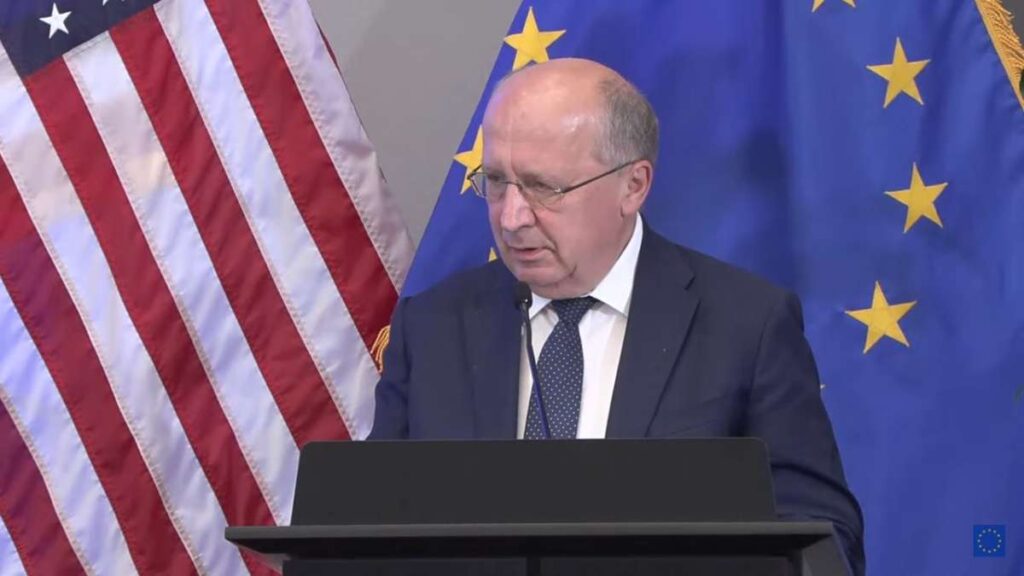By María Luque, Founding Partner at Future Literacy Group
Under the spotlight of the Gallup Building in Washington, and flanked by leaders from Lockheed Martin, Airbus, and the EIB Group, Andrius Kubilius made history as the first European Commissioner for Defence to speak on U.S. soil.
He did so during a new edition of the EU Defense Night, the annual event organized by the European Union Delegation to the United States to showcase the EU’s growing role in defence. The gathering brings together high-level officials, defence industry executives, policy experts, and media representatives from both sides of the Atlantic —including Escudo Digital.
With a calm yet surgical tone, Kubilius used his keynote speech to lay out Europe’s new strategic roadmap: self-defence, massive investment, and industrial independence in the face of what he called a “clear and present danger” from the Kremlin.
“I came here to say, first of all, that Europe is preparing to take responsibility for its own defence. You asked us to do that [Americans]. And we’re finally moving in that direction,” he began, while acknowledging: “You, the Americans, clearly have the right —and the long-term strategic logic— to pivot more and more towards the Indo-Pacific, in order to counter the growing military power of China.”
“And you have the right to ask us to take on responsibility for Europe’s defence. And we, the Europeans, must accept that U.S. position as logical. That’s why we need to draw our own logical conclusion: we must be prepared to assume that responsibility, especially when we see that the Russians are becoming increasingly aggressive,” he added.
Europe no longer just asks for protection
European defence has crossed the Rubicon —backed by unprecedented figures: up to 5% of Member States’ GDP will be allocated to defence in the new 2028–2035 budgetary cycle, amounting to as much as $5 trillion in cumulative spending. At least $2 trillion of that will go directly to military equipment —a figure with which the EU hopes to counter the continent’s most pressing threats, especially that posed by Russia.
“Putin is a clear and present danger. Russia produces more ammunition in three months than all of NATO does in a year, including the United States. We can’t keep depending on you,” Kubilius admitted to the well-attended U.S. audience, before warning of the major global risks posed by Moscow and Beijing by 2027.
“European intelligence services have publicly stated that Russia could be ready to challenge NATO within three to five years. Germany’s intelligence service recently said it has evidence —not just forecasts— that the Kremlin is actively discussing such plans. A stark warning also came last week from U.S. European Command and NATO’s Allied Command Europe. General Alexis Greenkevich said the alliance must prepare for the possibility of Russia and China launching wars in Europe and the Pacific simultaneously, with 2027 as a potential flashpoint.”
From the legacy of D-Day to structural self-defence
The event also honoured a World War II veteran —Dr. Arlester Brown— and the symbolism was clear: from the legacy of D-Day to structural self-defence. The private sector’s presence was equally significant. Representatives from Palantir, Rheinmetall, Lockheed, and Helsing were present for a direct message: the European defence business is about to multiply, but it won’t be an open door without conditions.
“European industries are already marketing their products as ITAR-free, like they were sugar-free sodas,” Kubilius quipped, referring to the U.S. regulations that restrict the export and use of military components involving American technology.
This was no offhand remark. ITAR regulation has become one of the main obstacles to transatlantic industrial interoperability. According to Kubilius, Europe currently spends 40% of its defence budget in the U.S., while the U.S. buys barely 1% from Europe. “There’s no reason to complain if we invest in our own industry. The current asymmetry is unsustainable,” he concluded.
Ukraine: much more than the first line of defence
Ukraine was mentioned more than a dozen times —not just as a moral cause, but as “the first line of defence” and a battlefield for military innovation. Drones, digital ecosystems, and AI-powered military systems are among the technologies being transferred from Kyiv to the heart of Brussels. “The battle for Ukraine is not just about Ukraine. It’s about Europe. It’s about the world. It’s about the United States too,” he stated.
Kubilius also confirmed the creation of a new joint platform with the Ukrainian government —Brave Tech EU— to develop combat-tested military technologies and accelerate Ukraine’s integration into the continental defence architecture. But this is more than talk. The EU regulatory framework is being reshaped. Bureaucracy to expand defence factories has been cut from four years to two months. €800 billion in defence programmes have already been approved through secure loans, and anti-air and military mobility projects are being accelerated. “The real competition won’t be over contracts, but over delivering on time. The hard part won’t be asking for more —it will be producing more,” the Commissioner said.
Kubilius spoke decisively about the need for a coordinated transatlantic roadmap to progressively replace U.S. capabilities with European ones. “What we want is clarity: to know what you will withdraw, when, and how we will replace it. Let’s avoid strategic surprises.”
The evening closed with a final appeal —not just for unity, but for symmetry. The message was clear: it’s not about breaking ties with the U.S., but about walking alongside it, with power of our own. The geopolitical Europe has arrived —and it wants both a voice and a vote in shaping the global chessboard.
